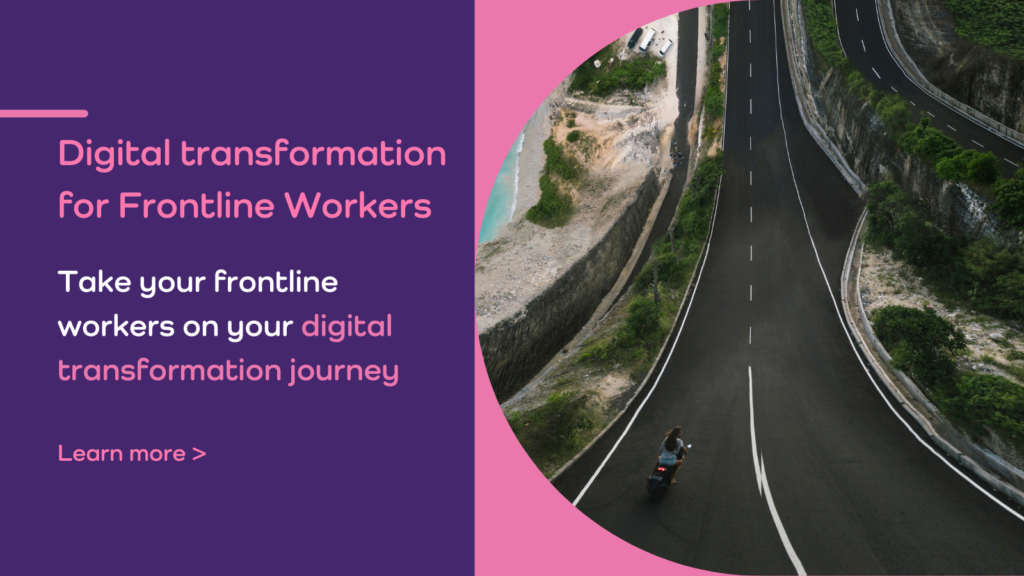Frontline workers are the public face of their organisations. From engineers, maintenance teams, and drivers, to retail assistants, healthcare workers, and hospitality staff, these are often the people charged with delivering the best possible experience for customers.
But what about your frontline workers’ user experience? Do they have the right tools and technology to do their jobs to deliver an exemplary customer experience?
In many cases the answer is no. A Forrester study found that there are significant gaps between the perceptions of management and the user experience of frontline workers. While 50% of managers believe their teams have the technology they need to work productively, only 23% of frontline workers agree that they have the right tools to do their jobs.
Cinderella syndrome and digital transformation
When it comes to digital transformation, frontline workers often feel like the neglected Cinderellas of their organisations. In many companies, digital transformation focuses on office-based employees (information workers), not the mobile workforce or those on the shopfloor. This results in digital inequalities, leading to frontline workers feeling under-supported and disengaged.
Those effected are a sizeable percentage of the global population (2 billion plus) and on average make up over half of an organisation’s workforce. So, it’s no surprise to learn that when they do have the right technology in their hands, they can make a real difference to an organisation’s bottom line.
A 2018 Forbes Insight/Microsoft survey found that “31% of organisations that have the highest degree of digital connectivity and empowerment—involving more than 75% of their frontline workers—saw more than 20% growth over the past year.”
How to deliver the best possible user experience for frontline workers
Providing technology for frontline workers is not just a case of giving them secure access to existing corporate systems and apps. It’s about making sure the technology delivers the best possible user experience, to boost adoption, productivity and see positive ROI from your technology investment.
Any digital transformation journey should start with a discovery phase to get an in depth understanding of your end users’ needs, challenges, working environment, existing technology, day-to-day activities, and objectives. This must involve talking to those people on the frontline, listening to their concerns and desires, and collaborating with them to identify the best possible solutions and to design a roadmap for a successful transformation project.
We believe that it is essential to get buy in from end users from the offset, taking them on the journey, rather than enforcing a technology change on them.
Key areas to think about include:
- Mobility: frontline workers such as engineers, drivers, maintenance teams and travel, hospitality & retail assistants are mobile by nature of their jobs. They need tools that are portable and the ability to connect securely to corporate networks, such as via cellular-connected devices.
- Collaborative technology: many frontline workers work in isolation and rely on updates from managers, teammates and even customers to manage their day-to-day tasks. Technology that enables digital communication and collaboration, and provides them with real-time access to information such as customer records and job information, drives efficiencies and increases productivity.
- Automation: repetitive and time-consuming tasks can be automated to free up frontline workers to focus on higher value work, like delivering a fantastic customer experience.
Empowering frontline workers
By understanding what your frontline users need to achieve and the current problems they face, you can put the user experience at the heart of your organisation’s digital transformation and empower your frontline workforce.
If you need a few more reasons to do so, here are 6 to get you started:
1. Improves operational efficiencies, cost savings and profitability
Process automation and digitally empowered frontline workers deliver greater cost savings, reduce unnecessary manual effort and management, and improve workforce efficiencies.
2. Increases productivity and collaboration between teams
Research has proven that digitally empowered frontline workers increase their productivity and performance. Increased collaboration also supports business innovation, making it easier to test new ideas and innovate.
3. Enhances decision making by capturing more data and real time metrics
Digitally empowered frontline workers can capture and access more data that leads to better decision-making both for the individual and the business as a whole.
4. Better customer satisfaction, boosting loyalty and brand reputation
Frontline workers are the public face of many organisations, and often the only point of contact. By empowering your workers with the right technology they have a greater ability to resolve issues fast and provide a better customer experience.
5. Empowers frontline teams to serve customers from anywhere
Boosting digital empowerment among frontline workers directly impacts the bottom line. When frontline workers can serve customers effectively with the right tools and information at their fingertips, they increase productivity, deliver results faster, and increase sales and revenue.
6: Boosts morale, employee engagement and satisfaction
When frontline workers are valued stakeholders in the digital transformation journey, organisations experience increased levels of job satisfaction, engagement, and a greater sense of connectedness. Digital technologies can help connect your frontline workforce to the company brand and culture, reducing churn and boosting morale.







